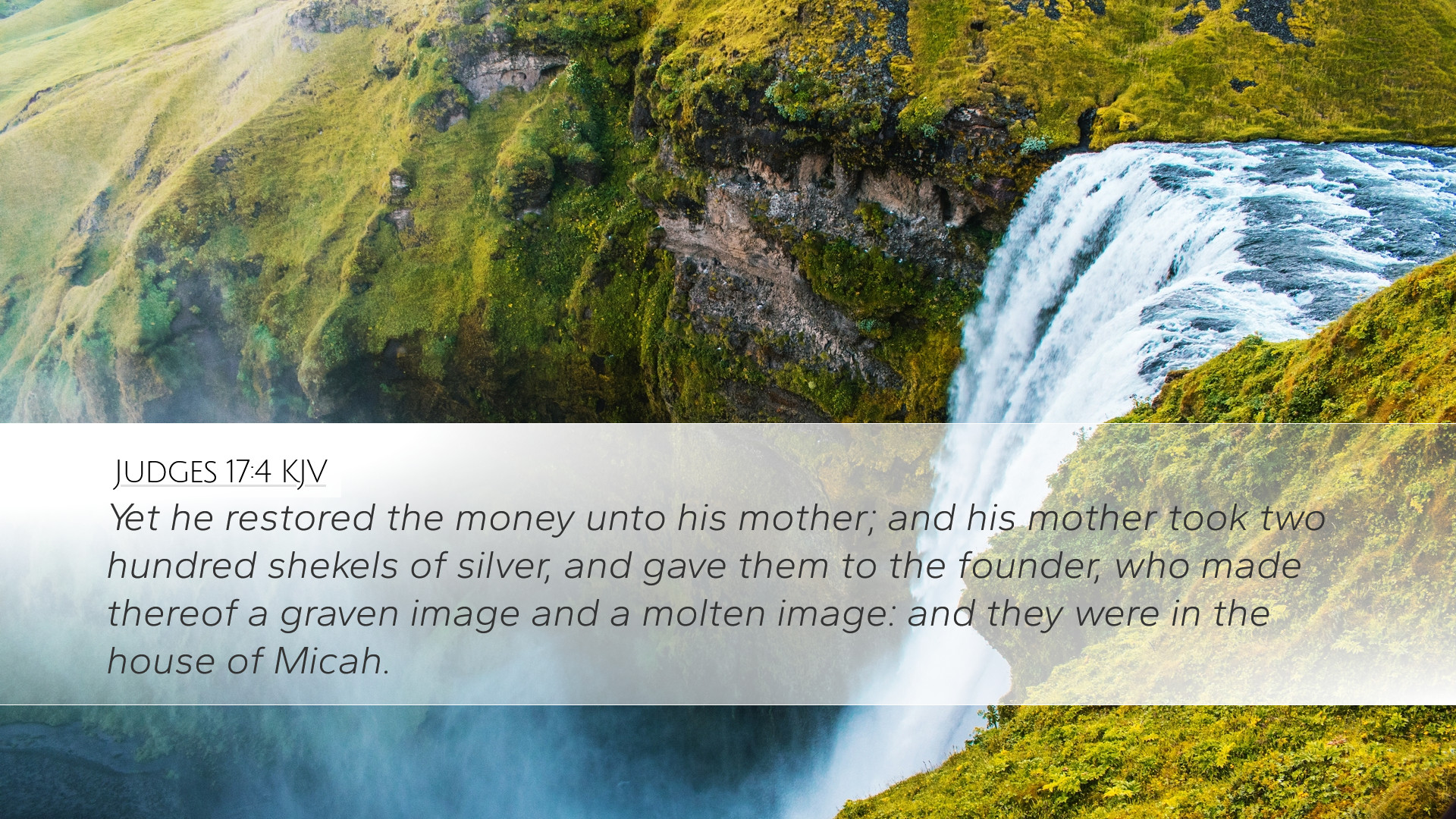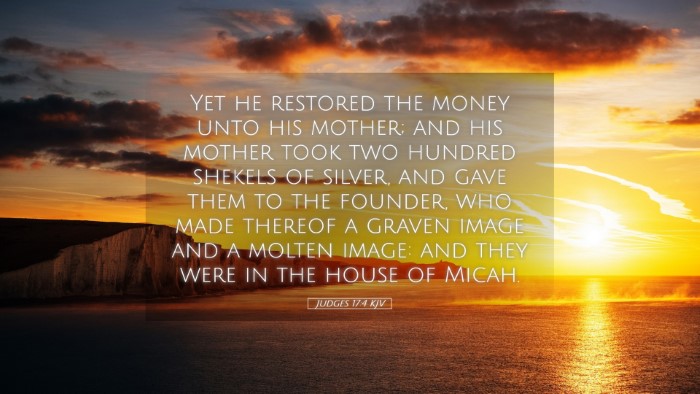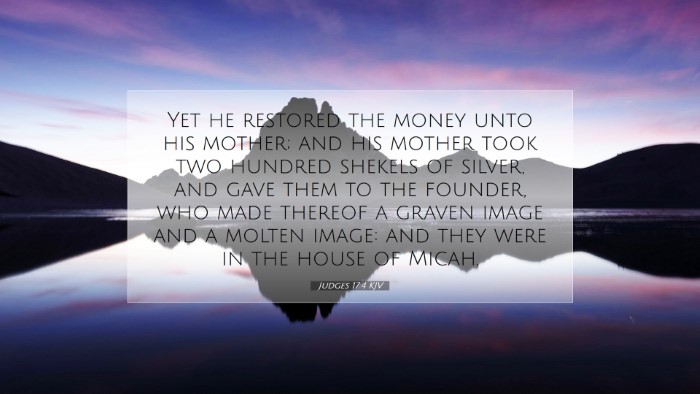Old Testament
Genesis Exodus Leviticus Numbers Deuteronomy Joshua Judges Ruth 1 Samuel 2 Samuel 1 Kings 2 Kings 1 Chronicles 2 Chronicles Ezra Nehemiah Esther Job Psalms Proverbs Ecclesiastes Song of Solomon Isaiah Jeremiah Lamentations Ezekiel Daniel Hosea Joel Amos Obadiah Jonah Micah Nahum Habakkuk Zephaniah Haggai Zechariah MalachiJudges 17:4
Judges 17:4 KJV
Yet he restored the money unto his mother; and his mother took two hundred shekels of silver, and gave them to the founder, who made thereof a graven image and a molten image: and they were in the house of Micah.
Judges 17:4 Bible Commentary
Commentary on Judges 17:4
Judges 17:4 reads: "Yet he restored the money unto his mother; and his mother took two hundred shekels of silver, and gave them to the founder, and he made thereof a graven image and a molten image: and they were in the house of Micah."
Introduction
This passage presents a significant moment in the narrative of Judges, illustrating the moral and spiritual decline of Israel during its history after the death of Joshua. In the context of the book, this verse sets the stage for understanding the consequences of idolatry within Israel, alongside individual moral choices and familial relationships that reflect the broader societal issues of the time.
Summary of Insights
- The Restoration of the Money: The act of returning the money by Micah demonstrates a complex interplay of guilt, familial relationships, and acknowledgment of wrongdoing.
- Idolatry and its Implications: The creation of graven and molten images reveals a profound departure from the worship of Yahweh, reflecting personal and communal abandonment of covenant fidelity.
- The Role of Micah: Micah is a pivotal figure—his actions symbolize the syncretism that characterized ancient Israelite religion, blending true worship with local customs and idols.
- The Mother’s Influence: The authority of Micah’s mother in this narrative showcases the familial dynamics within Israel and raises questions about parental influence on spiritual matters.
- Theological Reflections: This incident emphasizes the theological themes of corruption, the consequences of idolatry, and the understanding of God’s sovereignty amidst human rebellion.
Detailed Discussion
The Restoration of the Money
As Matthew Henry points out, Micah's return of the silver signifies not just a moral obligation but also a recognition of guilt and a desire for reconciliation. The complex relationship between mother and son here indicates the personal dimension of sin and atonement. Rather than just a legalistic return of funds, this restoration carries emotional and spiritual weight, reflecting the culture of the time where familial responsibilities played a crucial role in social order.
Idolatry and its Implications
Albert Barnes highlights the significance of the images crafted from the silver. This act of making idols is emblematic of Israel's cycle of disobedience. The graven and molten images indicate a mixture of worship practices that undermined the exclusivity of Israel’s covenant with God. The danger of such syncretism was not just a personal failing; it had a pervasive impact on the community, leading others into similar idolatrous practices.
The Role of Micah
Adam Clarke offers insight into Micah as a figure of transitional morality. His creation of idols and devotion to non-traditional worship methods illustrates the reality of a society in moral decline. Micah’s actions resonate with the archaeological and historical context of the period, showcasing how individuals appropriated religious symbols for personal or family spirituality, often sidelining core tenets of faith.
The Mother’s Influence
The mother's decision to commission the creation of idols highlights her significant role in shaping faith practices within her household. This dynamic suggests that spiritual decline can often begin within the home. The fact that she is responsible for steering her son towards idolatry brings into focus the powerful impact family leaders have on the belief systems of subsequent generations.
Theological Reflections
A deeper theological exploration reveals how Judges 17:4 encapsulates the tension between God's desire for exclusive worship and human propensity for idolatry. This passage forces readers to confront the reality of spiritual complacency. It serves as an admonition for contemporary readers to evaluate their own faith commitments and practices, drawing parallels to the potential for syncretism in today's spiritual landscape.
Conclusion
Judges 17:4 serves as a microcosm of the larger themes present in the book of Judges. The actions of Micah and his mother expose the interconnectedness of personal actions, familial influence, and broader cultural decay. For pastors, students, and theologians, these insights not only provide a historical understanding but also provoke introspection regarding the fidelity of contemporary worship practices and the need for a sincere commitment to covenant faithfulness.


